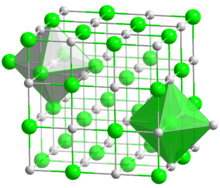 | |

| |
| Names | |
|---|---|
| IUPAC name
Lithium bromide
| |
| Identifiers | |
3D model (JSmol)
|
|
| ChemSpider | |
| ECHA InfoCard | 100.028.582 |
| EC Number |
|
PubChem CID
|
|
| RTECS number |
|
| UNII | |
CompTox Dashboard (EPA)
|
|
| |
| |
| Properties | |
| LiBr | |
| Molar mass | 86.845 g/mol[1] |
| Appearance | White hygroscopic solid[1] |
| Density | 3.464 g/cm3[1] |
| Melting point | 550 °C (1,022 °F; 823 K)[1] |
| Boiling point | 1,300 °C (2,370 °F; 1,570 K)[1] |
| 143 g/100 mL (0 °C) 166.7 g/100 mL (20 °C) 266 g/100 mL (100 °C)[2] | |
| Solubility | soluble in methanol, ethanol,[1] ether,[1] acetone slightly soluble in pyridine |
| −34.3·10−6 cm3/mol[3] | |
Refractive index (nD)
|
1.7843 (589 nm)[4] |
| Structure[5] | |
| Cubic, Pearson symbol cF8, No. 225 | |
| Fm3m | |
a = 0.5496 nm
| |
| Thermochemistry[6] | |
Std molar
entropy (S⦵298) |
74.3 J/mol K |
Std enthalpy of
formation (ΔfH⦵298) |
-351.2 kJ/mol |
Gibbs free energy (ΔfG⦵)
|
-342.0 kJ/mol |
| Hazards | |
| GHS labelling: | |

| |
| Warning | |
| H315, H317, H319[7] | |
| NFPA 704 (fire diamond) | |
| Flash point | Not-flammable |
| Lethal dose or concentration (LD, LC): | |
LD50 (median dose)
|
1800 mg/kg (oral, rat)[8] |
| Related compounds | |
Other anions
|
Lithium fluoride Lithium chloride Lithium iodide |
Other cations
|
Sodium bromide Potassium bromide Rubidium bromide Caesium bromide |
Except where otherwise noted, data are given for materials in their standard state (at 25 °C [77 °F], 100 kPa).
| |
Lithium bromide (LiBr) is a chemical compound of lithium and bromine. Its extreme hygroscopic character makes LiBr useful as a desiccant in certain air conditioning systems.[9]
- ^ a b c d e f g Haynes, p. 4.70
- ^ Haynes, p. 5.169
- ^ Haynes, p. 4.128
- ^ Haynes, p. 10.249
- ^ Seifert, H.-J.; Dau, E. (1972). "Über die Systeme Alkalimetallbromid/Mangan(II)-bromid". Zeitschrift für Anorganische und Allgemeine Chemie. 391 (3): 302–312. doi:10.1002/zaac.19723910311.
- ^ Haynes, p. 5.25
- ^ Lithium bromide. SIgma Aldrich
- ^ Chambers, Michael. "ChemIDplus – 7550-35-8 – AMXOYNBUYSYVKV-UHFFFAOYSA-M – Lithium bromide – Similar structures search, synonyms, formulas, resource links, and other chemical information". chem.sis.nlm.nih.gov. Retrieved 3 April 2018.
- ^ Wietelmann, Ulrich and Bauer, Richard J. (2005) "Lithium and Lithium Compounds" in Ullmann's Encyclopedia of Industrial Chemistry Wiley-VCH: Weinheim. doi:10.1002/14356007.a15_393.pub2
